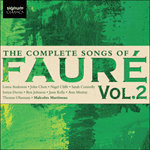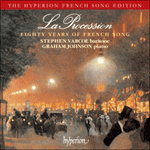Jankélévitch, master commentator on late Fauré in particular, notes that the sad grandeur of this song draws attention to the ambiguity between old age (the autumn of life) and autumn (the ageing of the year). A touch of modal harmony (the cadence at ‘L’accueillent en pleurant, de même’, for instance) also ages the music, a distancing whereby certain passages suggest a sixteenth-century madrigal. The composer was only fifty-seven at the time of writing it; earlier autumnal songs like
Chant d’automne and
Automne had been written by someone struggling to turn back the clocks, but this is already the older man’s philosophical acceptance of his mortality. It is one of only two settings of Catulle Mendès (the other is
La fleur qui va sur l’eau), a poet whose influence was very much on the wane when Fauré encountered him as a collaborator. Mendès had been one of the most relentlessly ambitious literati of an earlier age, but these two very different sensibilities came together at the right time to produce an unexpected masterpiece. (Alongside Chabrier’s
Chanson pour Jeanne this is the most eloquent musical legacy of a poet who had written more bad operatic libretti than most.) The key is G flat major, and the music glides resourcefully forward, always defying our tendency to second-guess the master’s infinitely subtle harmonic twists and turns, a companion piece to the equally enigmatic
Soir. This is the soft tread of the yellowing leaf, and the contemplation which comes from a future with a limited horizon. The melodic line is an extraordinary hybrid, tuneful in its way, but also near to a kind of recitative where the accentuations of the spoken word animate the music from within. If Fauré was far removed from being directly influenced by Debussy’s
Pelléas et Mélisande, this music definitely inhabits a post-
Pelléas world. There are some songs of Fauré’s late style that perplex the listener, but this one, on the very borders of the forest which forbids entry to all but the brave and determined, is one of the most immediately accessible.
from notes by Graham Johnson © 2005
Magistral commentateur, notamment du Fauré tardif, Jankélévitch note combien la triste grandeur de cette mélodie souligne l’ambiguïté entre la vieillesse (l’automne de la vie) et l’automne (le vieillissement de l’année). Une touche d’harmonie modale (ainsi la cadence à «L’accueillent en pleurant, de même») vieillit aussi la musique en une distanciation qui n’est pas sans rappeler, par endroits, un madrigal du XVIe siècle. Le compositeur avait seulement cinquante-sept ans lorsqu’il écrivit cette pièce; des mélodies automnales plus anciennes, telles
Chant d’automne et
Automne, reflétaient sa lutte pour remonter le cours du temps, tandis que celle-ci marque son acceptation philosophique, à un âge plus avancé, de sa propre mortalité. Il s’agit là d’une des deux seules mises en musique d’un texte de Catulle Mendès (l’autre étant
La fleur qui va sur l’eau), un poète dont l’influence était en net déclin lorsque Fauré le prit pour «collaborateur». Avant cela, Mendès avait été l’un des lettrés les plus implacablement ambitieux de son époque, mais ces deux sensibilités fort différentes se rencontrèrent au bon moment pour produire un chef-d’œuvre inattendu. (Avec
Chanson pour Jeanne de Chabrier, Dans la forêt de septembre est le plus éloquent legs musical d’un poète qui avait écrit son lot de mauvais livrets d’opéra). La tonalité est sol bémol majeur et la musique s’écoule ingénieusement, qui défie constamment notre tendance à essayer d’anticiper les méandres harmoniques infiniment subtils du maître—un pendant à
Soir, tout aussi énigmatique. C’est le doux piétinement d’une feuille jaunissante, la contemplation qu’éveille un avenir à l’horizon borné. La ligne mélodique est un extraordinaire hybride, harmonieuse à sa façon, mais proche, aussi, d’une manière de récitatif où les accentuations de la langue parlée animent la musique de l’intérieur. Certes, Fauré fut à des lieues d’être directement influencé par
Pelléas et Mélisande de Debussy, mais cette musique habite, sans aucun doute, un monde de l’après-
Pelléas. Certaines mélodies du style tardif de Fauré peuvent dérouter l’auditeur, mais celle-ci, sise juste à la lisière de la forêt autorisée aux seuls braves, aux seuls déterminés, est l’une des plus immédiatement accessibles.
extrait des notes rédigées par Graham Johnson © 2005
Français: Hypérion


 Fauré: The Complete Songs, Vol. 2
Fauré: The Complete Songs, Vol. 2 La Procession
La Procession
